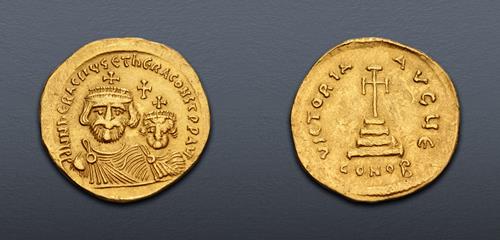|
Heraclius, with Heraclius Constantine. 610-641. AV Solidus (20.5mm, 4.49 g, 6h). Uncertain eastern mint, 5th(?) officina. Struck circa 613-circa 616(?). Crowned, draped, and cuirassed facing busts of Heraclius and Heraclius Constantine; cross above; all set on exergual line / Cross potent set on three steps; Є//CONOB. DOC 187a var. (unlisted officina; Alexandria); MIB 772-3 var. (same; Cyprus?); Bendall, Jerusalem 8 and 10 var. (same; Uncertain eastern military mint); cf. BN Alexandria AV/04 (for type and officina); SB 851 var. (same; Jerusalem); CNG XXVII, lot 1383. Lightly toned, reverse struck with clashed die. Good VF. Extremely rare, second, possibly third, known (if the BN specimen is actually officina Є).
From the David Welsh Collection. Ex Geneva Collection (Heritage 351, 3 June 2004), lot 12211 (erroneously as Constantinople, SB 734).
This solidus of Heraclius and Heraclius Constantine belongs to a rare and difficult series that has long consternated scholars and numismatists. The series is distinctly different from the common Constantinople solidi both stylistically and in the legend. Chronologically, it must date no earlier than 613, however, where exactly within the given timeframe it was struck remains a mystery. Additionally, as evidenced by the preponderance of diverging mint hypotheses, identifying the mint(s) wherein it was stuck also remains elusive.
This series has two distinct subtypes: those whose reverse legend ends simply in I, and those which end in IX or IΠ. The former is far rarer. Bendall wrote in his 2003 article that “the rare coins with I ... are possibly the earliest variety since there exists a solidus with the reverse legend ending I which later had an X added” (Bendall, 316). From the limited evidence available, the chronology of this series places the coins ending in I first followed by IX and IΠ.
This new coin first appeared in a 2004 auction. It was there, however, erroneously attributed alongside the Constantinople soldi and consequently went largely unnoticed. Appearing in the same distinctive style as its eastern solidi relatives, this coin presents a crucible in furthering the understanding of this difficult series. This note will focus on the potential explanations for this coin with a reverse legend ending in Є and what that may represent, as well as the series’ historical context. For more information on the stylistic differences of this series, please consult from Grierson, Two pp. 175-179 (1965).
After Phocas deposed Maurice Tiberius, the Sasanians invaded the eastern borders of the Byzantine Empire. Byzantine-Sasanian relations had been at their zenith since Maurice supported Khosrau II’s successful bid for the Sasanian throne. But once Maurice, Khosrau’s benefactor and father-in-law, was executed by Phocas, the Sasanian king used the unfavorable change in government to launch a retaliatory invasion. The war would drag on for over two decades and span the reigns of Phocas and Heraclius from 602-628. During the conflict, Jerusalem itself fell to the Sasanian forces in 614, and Egypt was occupied for the last ten years from 618-628. The losses and recaptures of major cities and mints during this conflict muddies the waters for better understanding this eastern series. Ultimately, it remains difficult to say which mint this series was struck at, or if it belongs to a transient military mint as Bendall suggested in 2003.
If this series followed the usual officinae of Byzantine coinage, this coin with an Є would make it the earliest example in this series. But given that the other known specimens end in I, IX, and IΠ, which does not follow a particular known sequence, it is difficult to say if the terminal letters even represent officina. The alternative possibility of them representing indiction or regal years is likewise speculative. Finally, it is also possible that this reverse die could be a mule from the Constantinople solidi.
In the end, this coin represents an exciting data point for this series with an extremely rare terminal letter in the reverse legend. However, until a new substantial group of this series is uncovered, it will likely remain difficult to effectively argue a thesis for this series’ ultimate attribution.
The final winners of all CNG Feature Auction 124 lots will be determined during the live online sale that will be held on 19-20 September 2023. This lot is in Session Three, which will begin 20 September at 9 AM ET.
Winning bids are subject to a 22.5% buyer's fee for bids placed on this website and 25% for all others.
We recognize that our users may have various Internet Browsers and Operating Systems. We like our visitors to have the best possible experience when using our bidding platform. However, we do recognize that it is impossible to develop applications that work identically, efficiently and effectively on all web browsers. The CNG bidding platform supports the latest stable major version and stable previous version of Chrome and Firefox.
|
